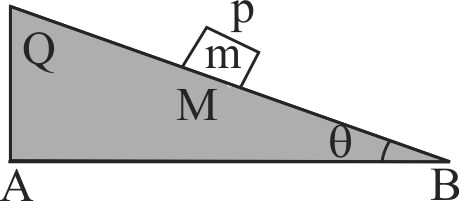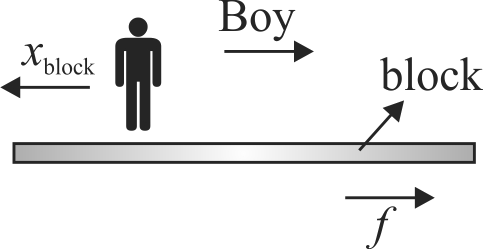365777 The centre of mass of three particles of mass \(1\;kg,2\;kg\) and \(3\;kg\) is at \((3,3,3)\) with reference to a fixed coordinate system. Where should be fourth particle of mass \(4\;kg\) be placed, so that the centre of mass of the system of all particles shifts to a point \((1,1,1)\) ?
365778
A wedge \(\mathrm{Q}\) of mass \(M\) is placed on a horizontal frictionless surface \(A B\) and a block \(P\) of mass \(m\) is released on its frictionless slope. As \(P\) slides by a length \(L\) on this slope of inclination \(\theta, \mathrm{Q}\) would slide by a distance of
365777 The centre of mass of three particles of mass \(1\;kg,2\;kg\) and \(3\;kg\) is at \((3,3,3)\) with reference to a fixed coordinate system. Where should be fourth particle of mass \(4\;kg\) be placed, so that the centre of mass of the system of all particles shifts to a point \((1,1,1)\) ?
365778
A wedge \(\mathrm{Q}\) of mass \(M\) is placed on a horizontal frictionless surface \(A B\) and a block \(P\) of mass \(m\) is released on its frictionless slope. As \(P\) slides by a length \(L\) on this slope of inclination \(\theta, \mathrm{Q}\) would slide by a distance of
365777 The centre of mass of three particles of mass \(1\;kg,2\;kg\) and \(3\;kg\) is at \((3,3,3)\) with reference to a fixed coordinate system. Where should be fourth particle of mass \(4\;kg\) be placed, so that the centre of mass of the system of all particles shifts to a point \((1,1,1)\) ?
365778
A wedge \(\mathrm{Q}\) of mass \(M\) is placed on a horizontal frictionless surface \(A B\) and a block \(P\) of mass \(m\) is released on its frictionless slope. As \(P\) slides by a length \(L\) on this slope of inclination \(\theta, \mathrm{Q}\) would slide by a distance of
365777 The centre of mass of three particles of mass \(1\;kg,2\;kg\) and \(3\;kg\) is at \((3,3,3)\) with reference to a fixed coordinate system. Where should be fourth particle of mass \(4\;kg\) be placed, so that the centre of mass of the system of all particles shifts to a point \((1,1,1)\) ?
365778
A wedge \(\mathrm{Q}\) of mass \(M\) is placed on a horizontal frictionless surface \(A B\) and a block \(P\) of mass \(m\) is released on its frictionless slope. As \(P\) slides by a length \(L\) on this slope of inclination \(\theta, \mathrm{Q}\) would slide by a distance of

